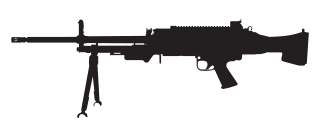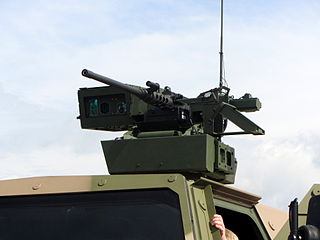Related Research Articles

A general-purpose machine gun (GPMG) is an air-cooled, usually belt-fed machine gun that can be adapted flexibly to various tactical roles for light and medium machine guns. A GPMG will typically feature a quick-change barrel design calibered for various fully powered cartridges such as the 7.62×51mm NATO, 7.62×54mmR, 7.5×54mm French, 7.5×55mm Swiss and 7.92×57mm Mauser, and be configured for mounting to different stabilizing platforms from bipods and tripods to vehicles, aircraft, boats and fortifications, usually as an infantry support weapon or squad automatic weapon.
The MG 34 is a German recoil-operated air-cooled machine gun, first tested in 1929, introduced in 1934, and issued to units in 1936. It introduced an entirely new concept in automatic firepower – the Einheitsmaschinengewehr – and is generally considered the world's first general-purpose machine gun (GPMG). Both the MG 34 and MG 42 were erroneously nicknamed "Spandau" by Allied troops, a carryover from the World War I nickname for the MG 08, which was produced at the Spandau Arsenal.
The MG 42 is a 7.92×57mm Mauser general-purpose machine gun designed in Nazi Germany and used extensively by the Wehrmacht and the Waffen-SS during the second half of World War II. Entering production in 1942, it was intended to supplement and replace the earlier MG 34, which was more expensive and took much longer to produce, but both weapons were produced until the end of World War II.

The Maschinengewehr 30, or MG 30 was a German-designed machine gun that saw some service with various armed forces in the 1930s. It was also modified to become the standard German aircraft gun as the MG 15 and MG 17. It is most notable as the design pattern that led to the MG 34 and MG 42, and thus is one of the major ancestors of many of the weapons in service which would later find widespread use into the 21st century.

The FN MAG is a Belgian 7.62 mm general-purpose machine gun, designed in the early 1950s at Fabrique Nationale (FN) by Ernest Vervier. It has been used by more than 80 countries and it has been made under licence in several countries, including Argentina, Canada, Egypt, India and the United Kingdom.
Rate of fire is the frequency at which a specific weapon can fire or launch its projectiles. This can be influenced by several factors, including operator training level, mechanical limitations, ammunition availability, and weapon condition. In modern weaponry, it is usually measured in rounds per minute or rounds per second.

The MG 3 is a German general-purpose machine gun chambered for the 7.62×51mm NATO cartridge. The weapon's design is derived from the World War II era MG 42 Einheitsmaschinengewehr that fired the 7.92×57mm Mauser round.

A heavy machine gun or HMG is a belt-fed machine gun that fires full-powered/magnum cartridges and is designed to be significantly more massive than light, medium or general-purpose machine guns. As the name implies, heavy machine guns are typically not man-portable by infantry and thus require mounting onto a weapons platform to be operably stable or tactically mobile, have more formidable firepower, and generally require a team of personnel for operation and maintenance.
The Heckler & Koch MG4 is a belt-fed 5.56 mm light machine gun designed and developed by German firearm manufacturer Heckler & Koch. The weapon was developed in the late 1990s and was first seen publicly in September 2001. It has been selected to replace the 7.62 mm MG3 general-purpose machine gun in the Bundeswehr at the squad support level; it will complement the MG3 in other roles. The MG4 will also be the secondary armament of the new Puma infantry fighting vehicle. Overall, it is designed to be light, provide maximum safety to the user and function reliably under adverse conditions using a wide range of ammunition from different manufacturers, without the need to adjust the gas system. The machine gun was initially known as the MG43 prior to its adoption by the Bundeswehr.

The Flak 30 and improved Flak 38 were 20 mm anti-aircraft guns used by various German forces throughout World War II. It was not only the primary German light anti-aircraft gun but by far the most numerously produced German artillery piece throughout the war. It was produced in a variety of models, notably the Flakvierling 38 which combined four Flak 38 autocannons onto a single carriage.
A muzzle booster or recoil booster is a device fixed to the muzzle of a firearm, intended to harness the energy of the escaping propellant to augment the force of recoil on portions of the firearm. Muzzle boosters are usually used to improve the reliability and/or rate of fire of a recoil operated firearm. The muzzle booster is distinct from the muzzle brake, which is designed to use the propellant gases to reduce the recoil of the firearm. However, unlike a muzzle brake, a muzzle booster uses the pressure of the expanding gases, rather than the reaction force, and it does not alter the felt recoil of the weapon, it merely adds more energy to the operating components.

The SIG MG 710-3 is a Swiss 7.62 mm general-purpose machine gun (GPMG) designed and manufactured by SIG - Schweizerische Industrie Gesellschaft. The weapon was developed as a commercial venture primarily for export, since the Swiss Army had already adopted the 7.5 mm MG 51 GPMG, produced by the federal arms factory W+F.
The STK 50 MG, formerly known as the CIS 50MG, is a gas-operated, air-cooled, belt-fed heavy machine gun developed and manufactured by Chartered Industries of Singapore in the late 1980s, in response to a request by the Singaporean Defence Ministry to replace the 12.7mm Browning M2HB machine guns then in ubiquitous service with the Singapore Armed Forces (SAF).
Ludwig Vorgrimler is the man most commonly associated with the design of the Spanish roller-delayed CETME rifle, and its prolific offspring from the German gunmaker Heckler & Koch such as the G3, HK21, P9 and MP5.

The Nanuk is a remote weapon station (RWS) used for light and medium calibre weapons which can be installed on any type of armoured vehicles or Brown water patrol vessel. It is designed by Rheinmetall Canada, in Quebec, Canada. The word Nanuk (ᓇᓄᖅ) means "Polar bear" in Inuktitut.

The MG 45 was a machine gun based on the MG 42, which was developed but not fielded in significant numbers by the German Army in World War II.

The Heckler & Koch MG5 is a belt-fed 7.62×51mm NATO general-purpose machine gun manufactured by German firearm manufacturer Heckler & Koch. The MG5 resembles the 5.56×45mm NATO Heckler & Koch MG4 light machine gun, which was adopted into German military service in 2005.
The RMG.50 is a German heavy machine gun under development by Rheinmetall.

FLW stands for "remotely operated, light weapon station" developed by the German defence company Krauss-Maffei Wegmann brands its family of remote weapon stations.
The Maschinengewehr 18 Tank und Flieger or MG 18 TuF, is a German dual-purpose heavy machine gun that was designed to fill both anti-tank and anti-aircraft roles. Developed at the end of the First World War, it fired the same 13.25 × 92 mm SR or tankpatrone 18 armor-piercing round used by the Mauser 1918 T-Gewehr anti-tank rifle.
References
- 1 2 Johnson, Steve (19 May 2013). "7.62mm MG3 + Two More Barrels + Motor = Rheinmetall Defence RMG 7.62 -". The Firearm Blog. Retrieved 25 February 2019.